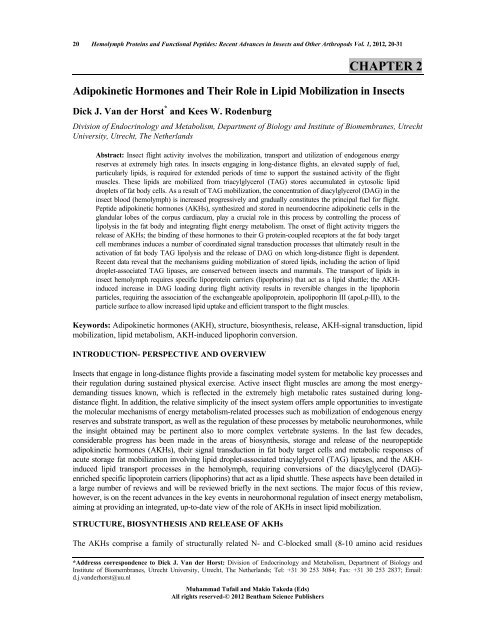chapter 1 - Bentham Science
chapter 1 - Bentham Science
chapter 1 - Bentham Science
You also want an ePaper? Increase the reach of your titles
YUMPU automatically turns print PDFs into web optimized ePapers that Google loves.
20 Hemolymph Proteins and Functional Peptides: Recent Advances in Insects and Other Arthropods Vol. 1, 2012, 20-31<br />
Muhammad Tufail and Makio Takeda (Eds)<br />
All rights reserved-© 2012 <strong>Bentham</strong> <strong>Science</strong> Publishers<br />
CHAPTER 2<br />
Adipokinetic Hormones and Their Role in Lipid Mobilization in Insects<br />
Dick J. Van der Horst * and Kees W. Rodenburg<br />
Division of Endocrinology and Metabolism, Department of Biology and Institute of Biomembranes, Utrecht<br />
University, Utrecht, The Netherlands<br />
Abstract: Insect flight activity involves the mobilization, transport and utilization of endogenous energy<br />
reserves at extremely high rates. In insects engaging in long-distance flights, an elevated supply of fuel,<br />
particularly lipids, is required for extended periods of time to support the sustained activity of the flight<br />
muscles. These lipids are mobilized from triacylglycerol (TAG) stores accumulated in cytosolic lipid<br />
droplets of fat body cells. As a result of TAG mobilization, the concentration of diacylglycerol (DAG) in the<br />
insect blood (hemolymph) is increased progressively and gradually constitutes the principal fuel for flight.<br />
Peptide adipokinetic hormones (AKHs), synthesized and stored in neuroendocrine adipokinetic cells in the<br />
glandular lobes of the corpus cardiacum, play a crucial role in this process by controlling the process of<br />
lipolysis in the fat body and integrating flight energy metabolism. The onset of flight activity triggers the<br />
release of AKHs; the binding of these hormones to their G protein-coupled receptors at the fat body target<br />
cell membranes induces a number of coordinated signal transduction processes that ultimately result in the<br />
activation of fat body TAG lipolysis and the release of DAG on which long-distance flight is dependent.<br />
Recent data reveal that the mechanisms guiding mobilization of stored lipids, including the action of lipid<br />
droplet-associated TAG lipases, are conserved between insects and mammals. The transport of lipids in<br />
insect hemolymph requires specific lipoprotein carriers (lipophorins) that act as a lipid shuttle; the AKHinduced<br />
increase in DAG loading during flight activity results in reversible changes in the lipophorin<br />
particles, requiring the association of the exchangeable apolipoprotein, apolipophorin III (apoLp-III), to the<br />
particle surface to allow increased lipid uptake and efficient transport to the flight muscles.<br />
Keywords: Adipokinetic hormones (AKH), structure, biosynthesis, release, AKH-signal transduction, lipid<br />
mobilization, lipid metabolism, AKH-induced lipophorin conversion.<br />
INTRODUCTION- PERSPECTIVE AND OVERVIEW<br />
Insects that engage in long-distance flights provide a fascinating model system for metabolic key processes and<br />
their regulation during sustained physical exercise. Active insect flight muscles are among the most energydemanding<br />
tissues known, which is reflected in the extremely high metabolic rates sustained during longdistance<br />
flight. In addition, the relative simplicity of the insect system offers ample opportunities to investigate<br />
the molecular mechanisms of energy metabolism-related processes such as mobilization of endogenous energy<br />
reserves and substrate transport, as well as the regulation of these processes by metabolic neurohormones, while<br />
the insight obtained may be pertinent also to more complex vertebrate systems. In the last few decades,<br />
considerable progress has been made in the areas of biosynthesis, storage and release of the neuropeptide<br />
adipokinetic hormones (AKHs), their signal transduction in fat body target cells and metabolic responses of<br />
acute storage fat mobilization involving lipid droplet-associated triacylglycerol (TAG) lipases, and the AKHinduced<br />
lipid transport processes in the hemolymph, requiring conversions of the diacylglycerol (DAG)enriched<br />
specific lipoprotein carriers (lipophorins) that act as a lipid shuttle. These aspects have been detailed in<br />
a large number of reviews and will be reviewed briefly in the next sections. The major focus of this review,<br />
however, is on the recent advances in the key events in neurohormonal regulation of insect energy metabolism,<br />
aiming at providing an integrated, up-to-date view of the role of AKHs in insect lipid mobilization.<br />
STRUCTURE, BIOSYNTHESIS AND RELEASE OF AKHs<br />
The AKHs comprise a family of structurally related N- and C-blocked small (8-10 amino acid residues<br />
*Addresss correspondence to Dick J. Van der Horst: Division of Endocrinology and Metabolism, Department of Biology and<br />
Institute of Biomembranes, Utrecht University, Utrecht, The Netherlands; Tel: +31 30 253 3084; Fax: +31 30 253 2837; Email:<br />
d.j.vanderhorst@uu.nl

















